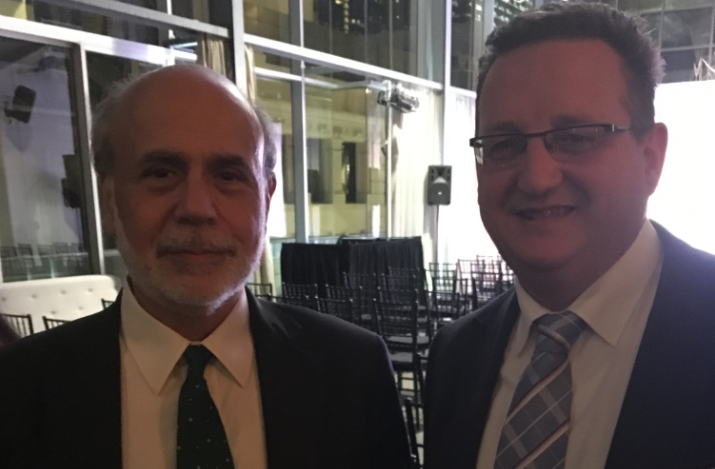Crisis management can be defined as the process by which an organisation deals with a disruptive and unexpected event that threatens to harm the organisation, its stakeholders, or the general public. I recently had the opportunity to meet and listen to Dr Ben Bernanke, who served two terms as Chairman of the US Federal Reserve between 2006 and 2014 – a man who can honestly say that he lived and breathed crisis management during his tenure at the US Federal Reserve.

Two titans of the finance world
Mentioning the name of Dr Bernanke in financial circles generally creates two distinct camps, those who believe that he acted correctly during the Global Financial Crisis (GFC) and prevented a global financial meltdown, and those who believe he bailed out the banks, artificially pushed up asset prices and planted the seeds of our future demise. The genesis of these arguments occurred ten years ago but it has done little to dispel the fervour both camps can bring to their argument.
My view is that the US Federal Reserve acted correctly in the initial stages, however, I think they let the party run too long and created some of the issues that we now face. That is not me trying to hedge my bets and sit on the fence, it is more a case of my opinion changing as the facts evolve. I consider myself to be a rational thinking person, my wife would argue too methodical at times, who tries to consider all sides of an argument before determining the best course of action moving ahead; in short, a reliable head when faced with crisis.
But each crisis can have a level of severity or scale of outcome; the dilemma of which outfit to wear on a Saturday night or which car to buy next, pale in significance compared to the doctor determining which drug to administer to save a life. Interestingly, one of the questions posed to Dr Bernanke was along the lines of ‘What was the most difficult decision you made?’. The quick answer was the bailout of AIG, the global insurance giant.
To put this into some context, keep in mind that the purpose of the US Federal Reserve is to protect jobs and to protect the stability of the currency. Or, in other words, to maximize employment and minimize inflation. It is not their purpose or intent to bailout floundering companies. The rationale for the bailout went along the lines that if the government opted to do nothing, as many argued it should, the result would be catastrophic, not just for those directly employed by AIG but for the whole world.
At the time that this decision was made, Bear Stearns had been sold to JP. Morgan and Lehman Brothers had collapsed. Following these corporate collapses, global credit markets started to freeze up and companies such as General Electric could not borrow to meet their day to day running costs. In short, no one trusted each other in the corporate world. In answering the question mentioned above, Dr Bernanke explained how AIG managed the pension plans of millions of American retirees, held US$1.5 trillion in life insurance policies and had immense investments in corporate America and Europe. On the one hand, bailing out such a company creates a moral hazard – if AIG is too big to fail, then what happens to the next company? Do we just bail everyone out? On the other hand, if we let AIG fail, could this be the iceberg that sinks the global economy? How do all those retirees get paid? What stops the onset of another GFC?
Dr Bernanke went on to outline how he and Hank Paulson, then US Treasury Secretary, held an emergency meeting with President Bush to explain the dangers of inaction and that the President recognised the need to act. The issue though was that there was no way he would be able to get what they wanted through Congress. The same day an emergency meeting of key congressional members from both parties was held and the same rationale was outlined. Whilst there was agreement some action was needed, there was no consensus on how that would come. A similar outcome still faced by many houses of parliament today.
Now, to many of us that is as far as we would take the issue. We identified the problem, warned the right people and counselled a course of action – if they then chose to not act as guided due to party politics, well that was not our problem! The politicians let global trade fail. In retrospect, I am glad that two people such as Dr Bernanke and Paulson were in charge, as they had the courage to act. Over the course of the next few days Dr Bernanke and Paulson put together a rescue package for AIG of some US$85 billion and a broader US$700 billion package for other corporates that were also on the brink. Both men put their reputations and future career prospects on the line for a cause that they firmly believed in.
Irrespective of whether we think both men acted correctly at the time, we should admire their ability to observe, plan and act when faced with a potential global calamity that could impact the lives of billions. I honestly believe that there would be fewer than a handful of people in the world who would have had the ability to act as clearly as they did in the face of such potential crisis.
Keep Wealth Partners Pty Ltd (AFSL 494858)
This information is of a general nature only and may not be relevant to your particular circumstances. The circumstances of each investor are different and you should seek advice from a financial planner who can consider if the strategies and products are right for you.







